This article is being considered for deletion in accordance with Wikipedia's deletion policy. Please share your thoughts on the matter at this article's entry on the Articles for deletion page. |
This is a chronological list of stagings of New York City Ballet co-founder and founding choreographer George Balanchine's ballet Who Cares? , made to songs of George Gershwin.

Ballet is a type of performance dance that originated during the Italian Renaissance in the fifteenth century and later developed into a concert dance form in France and Russia. It has since become a widespread, highly technical form of dance with its own vocabulary based on French terminology. It has been globally influential and has defined the foundational techniques used in many other dance genres and cultures. Ballet has been taught in various schools around the world, which have historically incorporated their own cultures and as a result, the art has evolved in a number of distinct ways. See glossary of ballet.
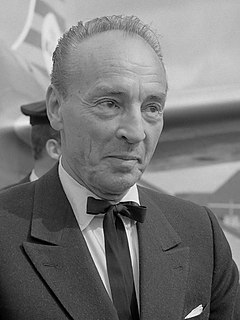
George Balanchine was an American ballet choreographer who was one of the most influential 20th-century choreographers. Styled as the father of American ballet, he co-founded the New York City Ballet and remained its Artistic Director for more than 35 years.
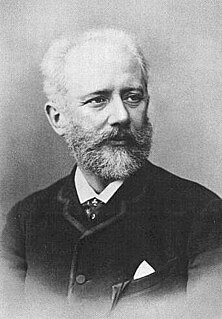
The Nutcracker is an 1892 two-act ballet, originally choreographed by Marius Petipa and Lev Ivanov with a score by Pyotr Ilyich Tchaikovsky. The libretto is adapted from E. T. A. Hoffmann's story "The Nutcracker and the Mouse King".
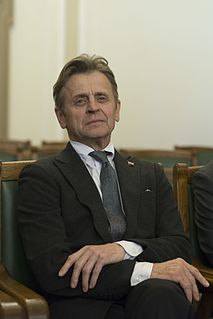
Mikhail Nikolayevich Baryshnikov, nicknamed "Misha", is a Latvian-born Russian-American dancer, choreographer, and actor. He is often cited alongside Vaslav Nijinsky, Rudolf Nureyev and Vladimir Vasiliev as one of the greatest male ballet dancers in history.
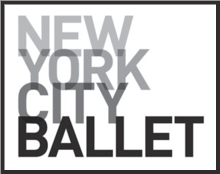
New York City Ballet (NYCB) is a ballet company founded in 1948 by choreographer George Balanchine and Lincoln Kirstein. Balanchine and Jerome Robbins are considered the founding choreographers of the company. Léon Barzin was the company's first music director. City Ballet grew out of earlier troupes: the Producing Company of the School of American Ballet, 1934; the American Ballet, 1935, and Ballet Caravan, 1936, which merged into American Ballet Caravan, 1941; and directly from the Ballet Society, 1946.
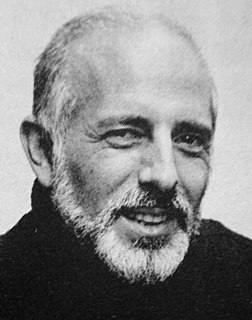
Jerome Robbins was an American choreographer, director, dancer, and theater producer who worked in classical ballet, on stage, film, and television. Among his numerous stage productions were On the Town, Peter Pan, High Button Shoes, The King and I, The Pajama Game, Bells Are Ringing, West Side Story, Gypsy, and Fiddler on the Roof. Robbins was a five-time Tony Award-winner and a recipient of the Kennedy Center Honors. He received two Academy Awards, including the 1961 Academy Award for Best Director with Robert Wise for West Side Story.

Jacques d'Amboise is an American danseur and choreographer.
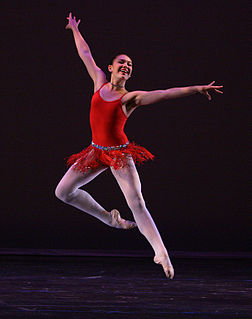
Contemporary ballet is a genre of dance that incorporates elements of classical ballet and modern dance. It employs classical ballet technique and in many cases classical pointe technique as well, but allows greater range of movement of the upper body and is not constrained to the rigorously defined body lines and forms found in traditional, classical ballet. Many of its attributes come from the ideas and innovations of 20th-century modern dance, including floor work and turn-in of the legs. The style also contains many movements emphasizing the bodies flexibility.

The Ballets Russes was an itinerant ballet company based in Paris that performed between 1909 and 1929 throughout Europe and on tours to North and South America. The company never performed in Russia, where the Revolution disrupted society. After its initial Paris season, the company had no formal ties there.
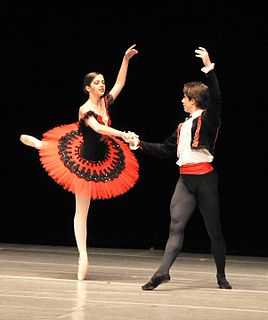
Don Quixote is a ballet in 3 acts, based on episodes taken from the famous novel Don Quixote de la Mancha by Miguel de Cervantes. It was originally choreographed by Marius Petipa to the music of Ludwig Minkus and first presented by the Ballet of the Imperial Bolshoi Theatre of Moscow, Russia on 26 December [O.S. 14 December] 1869. Petipa and Minkus revised the ballet into a far more expanded and elaborated edition in five acts and eleven scenes for the Imperial Ballet, first presented on 21 November [O.S. 9 November] 1871 at the Imperial Bolshoi Kamenny Theatre of St. Petersburg.

Apollo is a neoclassical ballet in two tableaux composed between 1927 and 1928 by Igor Stravinsky. It was choreographed in 1928 by twenty-four-year-old George Balanchine, with the composer contributing the libretto. The scenery and costumes were designed by André Bauchant, with new costumes by Coco Chanel in 1929. The scenery was executed by Alexander Shervashidze, with costumes under the direction of Mme. A. Youkine. The American patron of the arts Elizabeth Sprague Coolidge had commissioned the ballet in 1927 for a festival of contemporary music to be held the following year at the Library of Congress in Washington, D.C.

Miami City Ballet is an American ballet company based in Miami Beach, Florida, led by artistic director Lourdes Lopez. MCB was founded in 1985 by Toby Lerner Ansin, a Miami philanthropist. Ansin and the founding board hired Edward Villella, former New York City Ballet principal dancer to be the founding artistic director.
The Suzanne Farrell Ballet is a ballet company housed at the Kennedy Center, Washington, D.C., and founded in 2000 by Suzanne Farrell, one of George Balanchine's most celebrated ballerinas, and a former New York City Ballet principal dancer. Until 2017, the Suzanne Farrell Ballet was a full-fledged company produced by the Kennedy Center and had performed there since 1999 in addition to presenting extensive national and international tours. In September 2016, the Center announced that the company would be disbanding at the end of 2017, citing "possibilities of new expansion" and indicating that Farrell would likely return to "full-time teaching."
The Original Ballet Russe was a ballet company established in 1931 by René Blum and Colonel Wassily de Basil as a successor to the Ballets Russes, founded in 1909 by Sergei Diaghilev. The company assumed the new name Original Ballet Russe after a split between de Basil and Blum. De Basil led the renamed company, while Blum and others founded a new company under the name Ballet Russe de Monte-Carlo. It was a large scale professional ballet company which toured extensively in Europe, Australia and New Zealand, the United States, and Central and South America. It closed down operations in 1947.
Tschaikovsky Piano Concerto No. 2, originally called Ballet Imperial, is a ballet in three movements made by New York City Ballet's co-founder and founding choreographer George Balanchine for his earlier company, American Ballet Caravan, to the version of Peter Ilyitch Tchaikovsky's Piano Concerto No. 2, originally composed in 1879–80, but later revised by Alexander Siloti. The ballet was given a preview performance on 29 May 1941 at the Little Theater of Hunter College in New York City. The premiere took place on 25 June 1941 at Teatro Municipal, Rio de Janeiro.
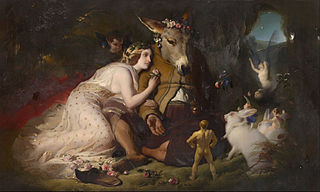
A Midsummer Night's Dream is a two-act ballet choreographed by George Balanchine to Felix Mendelssohn's music to Shakespeare's play of the same name. In addition to the incidental music, Balanchine incorporated other Mendelssohn works into the ballet, including the Overtures to Athalie, Son and Stranger, and The Fair Melusine, the "String Symphony No. 9 in C minor" and The First Walpurgis Night. A Midsummer Night's Dream, Balanchine's first completely original full-length ballet, premiered at New York City Ballet on 17 January 1962, with Edward Villella in the role of Oberon, Melissa Hayden in the role of Titania, and Arthur Mitchell in the role of Puck. They were joined by Francisco Moncion in the role of Theseus- Duke of Athens. The ballet employs a large children's corps de ballet. Act I tells Shakespeare's familiar story of lovers and fairies while Act II presents a strictly classical dance wedding celebration. The ballet dispenses with Shakespeare's play-within-a-play finale. A Midsummer Night's Dream opened The New York City Ballet's first season at the New York State Theater in April, 1964.

The Oklahoma City Ballet is a professional dance company and school located in Oklahoma City. The company began under the artistic direction of Ballet Russe de Monte Carlo dancers Yvonne Chouteau and Miguel Terekhov in the Science and Arts Foundation building on the Oklahoma City Fairgrounds,
Cyril Atanassoff is a Bulgarian dancer originally from France.
Balanchine technique or Balanchine method is the ballet performance style invented by dancer, choreographer, and teacher George Balanchine (1904–1983), and a trademark of the George Balanchine Foundation. It is used widely today in many of Balanchine's choreographic works. It is employed by ballet companies and taught in schools throughout North America, including the New York City Ballet and School of American Ballet, where it first emerged.